Tips for Flossing As a parent, you want the best for your child's dental health. While brushing twice a day is essential, there's another crucial habit that's often overlooked, and that is flossing. Flossing may seem like a daunting task, especially with young children, but it's a habit that can pay dividends in the long run. As a parent, you want the best for your child's dental health. While brushing twice a day is essential, there's another crucial habit that's often overlooked, and that is flossing. Flossing may seem like a daunting task, especially with young children, but it's a habit that can pay dividends in the long run.Flossing is an essential part of maintaining good oral hygiene, even for children. It helps remove plaque and food particles from between the teeth and along the gumline, preventing tooth decay and gum disease. However, flossing is sometimes challenging for children, especially when they are first learning. The Importance of Flossing for KidsBrushing alone simply can't reach all the nooks and crannies in your child's mouth. Food particles and plaque can accumulate in between teeth, leading to a buildup of bacteria that can cause cavities, gum disease, and other oral health issues. Flossing helps remove this debris, reducing the risk of these problems and promoting a healthier smile. Additionally, establishing good flossing habits early on can set your child up for a lifetime of optimal oral hygiene. Tips for Making Flossing Fun and EffectiveIt is never too early to start flossing. As soon as your child's teeth start to touch, usually around the age of two or three, you can begin incorporating flossing into their oral hygiene routine. We know that getting kids to floss is sometimes challenging, but with a little creativity and persistence, it can become a seamless part of their daily routine. Here are some tips to make flossing an enjoyable experience for your child:
By making flossing a fun and engaging experience, you're setting your child up for a lifetime of good oral health. Remember, consistency and patience are key. It may take time, but the benefits are well worth the effort. |
 |